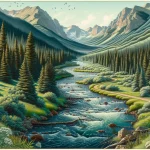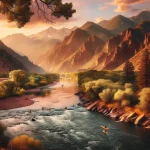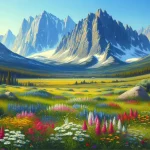Nestled in the rugged and remote setting of the Sierra Madre Range near the Wyoming-Colorado border, the North Fork Little Snake River offers a unique blend of outdoor adventures, stunning natural beauty, and rich history. This hidden gem is a paradise for fly fishing enthusiasts, hikers, and nature lovers seeking an escape from the hustle and bustle of city life.
In This Article
TL;DR
- An exploration of diverse outdoor activities available in the region, including fly fishing, hiking, and camping.
- Highlighting the unique fly fishing experiences on North Fork Little Snake River, home to rare cutthroat trout.
- Emphasizing the natural beauty and wildlife of the area, with opportunities for photography and wildlife spotting.
Exploring the Great Outdoors
The North Fork Little Snake River is situated in a picturesque landscape characterized by lush grasslands, towering pines, and red sandstone formations. The river cuts through a scenic canyon, creating idyllic fishing spots and breathtaking viewpoints. Hikers can explore trails that wind through the surrounding wilderness, offering chances to spot local wildlife such as elk, deer, and bird species.
The area provides several camping sites for those looking to immerse themselves in nature or experience family adventures. Be sure to familiarize yourself with the regulations and guidelines for overnight stays to ensure a responsible and enjoyable camping experience.
The Thrill of Fly Fishing
Fly fishing enthusiasts will find North Fork Little Snake River to be a true haven. The river is renowned for its thriving population of cutthroat trout, one of the rarest native trout species in Wyoming. The Wyoming Game and Fish Department has implemented conservation efforts to maintain the reproduction and growth of adult and juvenile fish, ensuring their survival and genetic purity.
When planning your fly fishing adventure, it’s essential to adhere to local fishing regulations. Anglers can catch and keep up to three trout daily, with only one cutthroat over 12 inches long. Fishing is permitted from July through May, with the peak season being from May to June.
Wildlife and Nature Conservation
The North Fork Little Snake River area is home to a diverse array of flora and fauna. Visitors can spot various wildlife species, including cutthroat trout, elk, deer, and a wide range of bird species. The Wyoming Game and Fish Department has been actively studying and monitoring the local cutthroat trout population since the late 1950s to ensure their conservation and genetic purity.
As a visitor, you can contribute to conservation efforts by following fishing regulations, practicing catch-and-release, and minimizing your impact on the environment. Take your river guest responsibility seriously, and follow Leave No Trace principles. Stay on designated trails, properly dispose of waste, and respect the habitats of the local wildlife.
Seasonal Activities and Events
The North Fork Little Snake River region offers a variety of activities throughout the year. During summer, fly fishing, hiking, and camping are popular pursuits. Visitors can enjoy the stunning display of autumn colors while exploring the trails or casting a line in the river.
Winter brings snowshoeing and cross-country skiing opportunities, allowing you to experience the serene beauty of the snow-covered landscape. Be sure to check local conditions and come prepared with appropriate gear for your chosen activities.
Photography and Scenic Spots
The stunning landscapes surrounding the North Fork Little Snake River will inspire both amateur and professional photographers. The combination of rugged terrain, lush vegetation, and crystal-clear waters creates a picturesque setting for memorable shots.
Some of the most scenic spots include the river canyon, nearby grasslands, and the Sierra Madre Range in the background. Early morning and late afternoon are ideal times for photography, as the soft light enhances the area’s natural beauty.
Local Culture and History
The North Fork Little Snake River area has a fascinating history dating back to the late 1800s when copper mining was prevalent in the region. Although the mines are no longer operational, remnants of this bygone era, including rusted rail cars, building remains, and old machinery, can still be found scattered throughout the area.
Exploring these historical sites provides a glimpse into the lives of the miners and the challenges they faced in this rugged landscape. The river has significantly shaped the local communities and their way of life, from mining to ranching and outdoor recreation.
Essential Travel Tips
When planning your trip to North Fork Little Snake River, be sure to pack appropriate clothing and gear for your intended activities. Bring layers to accommodate changing weather conditions, sturdy hiking shoes, and sun protection.
The area is remote, so it’s essential to come prepared with sufficient food, water, and any necessary supplies. Cell phone coverage may be limited, so consider bringing a map, compass, or GPS device for navigation.
Remember to practice Leave-No-Trace principles to minimize your impact on the environment. Pack out all trash, respect wildlife, and stay on designated trails to preserve the area’s natural beauty for future generations.
FAQ
What are the best times of year to visit North Fork Little Snake River for fly fishing?
The peak fly fishing season on North Fork Little Snake River is from May to June, with opportunities for good fishing from July through May. Be sure to check local regulations and obtain any necessary permits before casting your line.
Can you recommend any family-friendly activities in the area?
Families can enjoy hiking, camping, and wildlife spotting in the North Fork Little Snake River area. There are several easy to moderate trails suitable for children, and the campgrounds provide a great opportunity for bonding and experiencing nature together while you experience new family adventures.
What are the camping regulations I should be aware of?
When camping in the North Fork Little Snake River area, an important river guest responsibility is to follow Leave No Trace principles. This includes camping in designated sites, properly disposing of waste, and minimizing campfire impacts. Be sure to check with local authorities for additional regulations or permits.
How can I contribute to conservation efforts while visiting?
You can contribute to conservation efforts by practicing responsible outdoor ethics. Follow fishing regulations, practice catch-and-release when appropriate, stay on designated trails and properly dispose of waste. By minimizing your impact and respecting the environment, you help preserve the area’s natural beauty.
Are there any permits required for hiking or fishing in the area?
Fishing permits may be required to fish in the North Fork Little Snake River. Check with the Wyoming Game and Fish Department for the most up-to-date information on permits and regulations. No specific permits are typically required for hiking, but it’s always a good idea to check with local authorities for any updates or changes.
Can I go whitewater rafting or kayaking in the North Fork Little Snake River?
A small boat such as a kayak or canoe may be used in sections of the Little Snake River, but it is far too shallow and full of obstacles such as fencing and metal to lend itself to whitewater rafting. Contact the National Park Service for any rafting questions you may have, as it will have the most accurate and up-to-date information.






